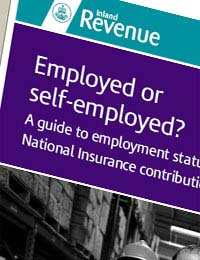Who to Tell: Registering as Self-Employed

At first glance becoming self-employed is clearly defined in law. The reality is that you have to decide whether your new working format is actually defined as self-employed as far as paying tax and National Insurance is concerned. This will guide you to which agencies you have to tell about your new status as a self-employed person.
The confusion can arise when your self-employment is under contract. If you sub-contract your services as a consultant for instance, you may not actually be defined as self-employed. The HMRC (HM Revenue & Customs) leaflet IR56 ‘Employed or self-employed?’ gives more details. You can download a copy from: www.hmrc.gov.uk/pdfs/ir56.pdf. The HMRC also have a special starting a business website you can visit at: www.hmrc.gov.uk/startingup.
Income Tax
As a previous employee your employer automatically deducted income tax from your salary. When you are self-employed, you are responsible for these payments. You must inform HMRC about your new self-employment within three months or you will be fined. The guide ‘Working for Yourself’ contains all the information you need. This can be downloaded from the HMRC website: www.hmrc.gov.uk/startingup/working-yourself.pdfThe most efficient method of informing HMRC about your self-employment is to use their online service. You can also inform HMRC about your new self-employment by calling them on 0845 915 4515. Alternatively, you can download a leaflet that contains the paper forms you need to complete and return to the HMRC. You can download the leaflet ‘Are you thinking of working for yourself?’ from: http://www.hmrc.gov.uk/leaflets/se1.pdf.
National Insurance
Just as your employer deducted the income tax you owe from your salary, they also deducted National Insurance contributions. You are now responsible for these. As a self-employed person you are now liable for Class 2 contributions that are a fixed weekly amount, and Class 4, which is a percentage of your profits. The leaflet ‘Are you thinking of working for yourself?’ contains the forms you will need to complete to set-up a direct debit to pay your Class 2 contributions as this is the usual way that most self-employed people pay this class of National Insurance. More information is on the National Insurance website: www.hmrc.gov.uk/nic.Tax Credits
If you currently receive any kind of tax credits, your entitlement to these benefits may change as you are moving from being a employee, into becoming self-employed. Your benefit may not change at all, but you must still inform your local Jobcentre Plus as they need to know the details of your change in circumstances.VAT and Self-employment
Whether you register for VAT is dependent on two factors. If you will be buying a lot of goods and services that have VAT attached to them, it may be an advantage to voluntary register for VAT so you can claim the VAT you have paid back at the end of the year. Talk to your accountant about this as you will have to make sure you can show in your accounts the VAT you have paid.The other factor in VAT that self-employed people need to think about is the goods and services that they sell. If your business will sell more than £67,000 worth of goods or services in any given year that are liable for VAT, you must register and start to collect this tax from your customers when your income goes over this threshold. Revenue and Customs must be informed within a month of you going over the threshold. You can read an introduction to VAT on the HMRC website.


Re: What Licences Do I Need to Import Wine?
Wazza - Your Question:Hi, I am looking into importing kegs of frizzante from Italy, the kegs are 24 litres & there…
Re: What Licences Do I Need to Import Wine?
Hi, I am looking into importing kegs of frizzante from Italy, the kegs are 24 litres & there are 42 kegs on a…
Re: What Licences Do I Need to Import Wine?
BOR - Your Question:Hi,I would like to import wine from the EU to sell in the UK. We have a vineyard over there but…
Re: What Licences Do I Need to Import Wine?
Hi, I would like to import wine from the EU to sell in the UK. We have a vineyard over there but have expert help…
Re: What Licences Do I Need to Import Wine?
Hi, I wish to import wine from Bulgaria-400 bottles and resale in UK How much is the import duty. Many Thanks
Re: What Licences Do I Need to Import Wine?
I would like to import wines from a French wine warehouse for resale in the UK. Can you tell me how difficult it is…
Re: Getting Funding for Your Small Business, London: Case Studies
gilly - Your Question:I.m am a salon owener really struggling to get by,i.ve already…
Re: Getting Funding for Your Small Business, London: Case Studies
I.m am a salon owener really struggling to get by,i.ve already trained someone up but…
Re: What Licences Do I Need to Import Wine?
@Kellie. Here is the government information on importing wine, the regulations regarding labellling, ingredients etc…
Re: What Licences Do I Need to Import Wine?
Hello, could you please give us some advise? We would like to import prosecco from Italy into the uk for resale. How…